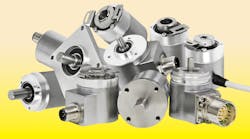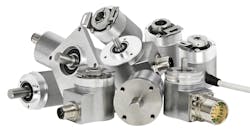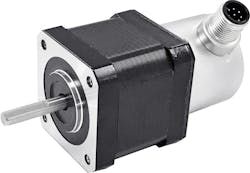Is Integrated Motor Feedback Pushing Standalone Encoders to the Sidelines?
An interesting trend in industrial motion control has been the replacement of self-contained encoders (rotation sensors with their own housing, bearings and shaft) with modular or “kit” encoders. These new devices are designed to be installed on or inside the motor housing, with rotary motions measured directly from the host’s shaft. Integrating position feedback devices into motors or other types of machines can save costs and simplify machine designs. But this does not mean the end of the road for traditional standalone encoders.
About Encoders
Rotary encoders have been key components in motion control systems since the earliest days of digital controls, translating rotary motion into a digital feedback signal for a control system’s PLC, microcontroller or computer.
Standalone encoders, which have their own shaft, bearings, housing and seals, have long been a popular choice with machine builders and system integrators. These devices, which are manufactured in a huge variety of sizes, shapes and performance characteristics, can be installed virtually anywhere in a machine where it is necessary to monitor rotary motions.
However, since many industrial motion control systems are powered by electric motors, there has been growing interest in integrating motion and position feedback into motors, creating servomotors or feedback-controlled stepper motors. The drivers here have been cost and an interest in simplifying designs by reducing the number of separate components.
For integrated motor feedback, the measurement components of an encoder are attached to a motor’s housing, with rotary motions measured directly from the drive shaft. The technologies used in these integrated devices are often closely related to those used in standalone encoders, and these devices—referred to as kit, or modular encoders—are in many cases unbundled versions of their standalone counterparts.
Integrated Motor Feedback
Servomotors are frequently used for precise position control in robots or high-accuracy machine tools. Optical encoder technology has been a favorite in this area because of its accuracy and excellent dynamic response. However, a new generation of precision magnetic encoder components offers an attractive alternative. These feature compact form factors (as small as 22 mm diameter) and are less susceptible to dust, moisture or shock and vibration than optical encoders.
Magnetic encoders are also easier to install under normal factory conditions since they can tolerate moderate misalignments between the shaft and the measurement module. Further, magnetic encoders are available with multiturn measurement capabilities, based on self-powered rotation counters energized by Wiegand energy harvesting technology. This elegant solution eliminates the need for backup batteries or the complex geared code disk systems used in some multiturn optical encoders.
Kit encoders can also be installed on stepper motors to provide integrated feedback to the control system, improving accuracy by eliminating positioning errors due to skipped steps. (This can become a significant problem at higher speeds when the torque output from stepper motors is reduced and the likelihood of missed steps increases.)
A big attraction of stepper motors is their relatively low cost, especially when compared to high-end servomotors. It follows, then, that cost is an important consideration when choosing an integrated encoder solution. Simple, inexpensive optical incremental encoders can confirm to the control system whether a step motion has been completed as requested, improving accuracy.
For more demanding position control applications, absolute encoders can be a better choice since these provide the controller with a complete picture of the rotary position of the motor’s shaft, including the number of rotations that have been completed. Cost-effective multiturn magnetic absolute encoders are well suited for this task.
Hollow-Shaft Kit Encoders
The kit encoders described above are often mounted on the non-drive end of the motor (see the image above). In some cases, though, it is useful to be able to position the rotation measuring elements at the drive end of a motor. Ring-shaped hollow-shaft encoders can be installed around the drive shaft or in other positions in the drive train.
For example, when the drive system includes torque-amplifying reduction gears, hollow-shaft encoder elements can be mounted at the output end of the drive to avoid positioning errors caused by backlash in the gear train. For robot arm or wrist joints, angular deflections can be measured directly at the joint with hollow shaft elements built into the arm sections. The large central openings are available to route cables and media hoses inside the structure.
Bearing-Less Encoders
Bearing-less encoders are a relatively new concept that retain the robust housing of standalone encoders, but with the rotating part of the measurement system (e.g., permanent magnet for magnetic encoders) attached directly to the shaft of the host machine. This arrangement eliminates the bearings and seals of conventional standalone encoders, saving space and reducing costs. The outer shell protects the measurement elements from physical damage.
A Continuing Role for Standalone Encoders?
Although integrated motor feedback is taking a growing share of the market for motion control systems, the future for standalone encoders continues to look bright. The driver here is the explosive growth of digital motion and position control systems of all types. With dramatic advances in encoder technology, including the use of powerful microprocessors and sophisticated signal processing algorithms, many exciting new applications areas are becoming technically and economically feasible.
Modern digital encoders, both integrated and standalone, are significantly smaller, tougher and cheaper than their predecessors, making them viable in areas beyond their original base of manufacturing and industrial automation. Small, inexpensive encoders, paired with digital controls, have emerged as high-performance replacements for older analog systems based on potentiometers or resolvers in areas like mobile machinery, medical equipment or even consumer electronics.
In the area of industrial motion control, standalone encoders still dominate important niches. Standalone encoders remain an excellent solution for machines that use non-electric prime movers like pneumatics or hydraulics. As well, since standalone devices can be installed close to the “work-face,” they can be used to avoid loss of positional accuracy that can occur when a motor’s power is transmitted through long gear trains, belts or other mechanisms.
There are also economic factors beyond the cost of devices. For example, standalone absolute digital encoders often support fieldbus or Ethernet communications that use shared-cable (e.g., daisy-chain) wiring systems. This enables much simpler wiring layouts than would be possible with point-to-point analog or serial communications. Modern encoders with advanced communications may also feature self-diagnostic capabilities that speed maintenance and troubleshooting.
In summary, motion control plays a critical role in many emerging industries, including wind and solar power, autonomous guided vehicles (AGVs), robots/cobots and surgical tools. The special requirements in each of these areas will mean new requirements for encoders of all sorts, integrated and standalone.
Simplifying Encoder Replacement for MRO
Standalone encoders have been installed in an enormous range of machinery, and while most of these have often provided long, reliable service, wear and age can degrade their performance and reliability. When it comes time to find a replacement, machine owners may be in for a rude shock: Older models can be hard or even impossible to find.
Encoder maker Posital is making it easier to find suitable replacements for hard-to-find devices. Thanks to their modular design philosophy and manufacturing technology, the company is able to build new encoders with mechanical, electrical and performance characteristics that duplicate those of their and other manufacturers’ older products, while keeping costs down. Posital’s Encoder Match tool enables customers to enter the model number of products from many manufacturers and to find functionally equivalent models from the company’s catalog.
Christian Fell is director of Technology Development, Posital-Fraba Inc., Kingston, N.J.




